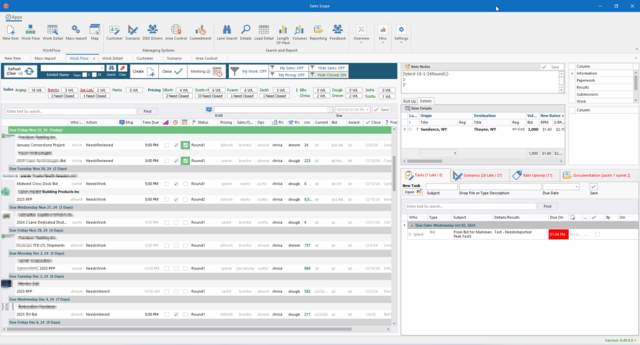CCJ Innovators profiles carriers and fleets that have found innovative ways to overcome trucking’s challenges. If you know a carrier that has displayed innovation, contact CCJ Chief Editor Jason Cannon at [email protected] or 800-633-5953.
In a small trucking company, pricing and strategy insights can be shared informally among core team members. However, as the company grows, it becomes crucial to ensure this information is systematically communicated to everyone.
Nussbaum Transportation (CCJ Top 250, No. 146) built proprietary program, Sales Scope, to help people price bids efficiently. While it used to take hours to do manually, the custom tool allows the company to deal with a shipper’s RFP in just seconds.
Leveraging automation and data
Nine years ago, Tyler Dietrich, director of product at Nussbaum, joined as a pricing analyst for the Hudson, Illinois-based carrier, which, at the time, was a smaller company of around 250 trucks. With his penchant for Microsoft Excel, the company tasked Dietrich to design a process to boost efficiency in the pricing department.
“I wrote an application where in Excel, you could paste an entire customer RFP, and then it would use different parts of Excel and a lot of formulas to sort of help you price it faster,” Dietrich explained. Though the tool quickly outgrew itself and didn’t work out, Dietrich and the development team, along with support from the company’s CIO Douglas Knepp, worked on coding and programming roadblocks.
Eventually, Dietrich and the team created a custom tool. “What we did is allow you to take a customer RFP and dump thousands of lanes into this helper import [feature]. It will automatically clean up the data, align it, and standardize it, and then dump it into a database. That database is then accessed by the company’s proprietary program, Sales Scope,” he explained.

Sales Scope has multiple uses, Dietrich said. To set it up, the program standardizes and streamlines large datasets. As RFPs differ, Dietrich said they kept in mind, “How do you make it something that can be easily digested by the teams that are going to work on it and get the best rates or the right rates for your network?”
After further data conversion to ensure the data’s accessibility with the system, Sales Scope has a Workflow tab that offers an overview of various tracks of items, action items by team members, and due dates. Dietrich noted that this was inspired by seeing his predecessor having a simple notepad with due dates, while the Workflow allows a detail-oriented view on each team member’s bids status.
The tool eliminates the silo mentality with its features, such as Workflow’s feature that enables team members to flag bids to be discussed in upcoming meetings. “All along, we’re looking for ways to make it so everyone can see what needs to be seen and address what needs to be addressed,” said Dietrich.
Another feature, Work Detail, offers a visual indicator of the bidding process. As an example, for a lane from Sundance, Wyoming to Thane, Wyoming, the company can compare rates for customer miles, practical mile from PC*MILER, DAT rates, hours of service, and other factors that can give an indicator whether it aligns with the company’s pricing strategy. Factors are approved by a manager and salesperson, allowing analysts and all team members to align on shared pricing strategies.
Beating the numbers game
The biggest impact of the tool, Dietrich said, was boosting efficiency on processing RFPs. “We can have a single analyst pricing probably 1,000 lanes a day because we can have this import tool in Excel running and lining up and cranking our miles and pulling in tolls and kind of pre-processing,” Dietrich said. “Whereas before, that would have been hours just to start to get my head wrapped around what they were.”
“We’re somewhere around 10 times more efficient than we were doing when we were doing bids manually,” Dietrich added. “It's how much quicker we can process bids and with greater accuracy.”
Especially in a low market, this is a numbers game, Dietrich pointed out. “If you can’t crank enough bids, you’re just not going to find enough opportunities.”
As another plus, with Sales Scope, when the analysts pull in a bid, especially with a large customer, as part of the process is the mass import, it can check Nussbaum’s network for the last 3 to 5 years to compare loads and profitability, though they most often pull last year’s data for the most relevant profitability data.
Other companies have tried to buy the custom tool whenever Nussbaum showed their approach.
For trucking companies interested in adopting similar tools, Dietrich said, “Think about what data you have, what people know, and what your systems currently have in them, whether it be your tracking profitability or operating ratio or some sort of yield metric,” he advised. “If you’re going to build the best bidding software for you, it’s using your own data that only you know and applied in the strategies that have made you successful so far.”
The CCJ Innovators program is brought to you by Bestpass, Chevron Delo, Comdata and Freightliner Trucks.













